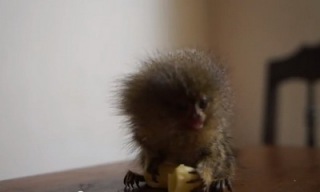Monkeys, like most animals get cuter the smaller they are. Enter the The pygmy marmoset (Cebuella pygmaea), the smallest monkey in the world. It only reaches to about six inches tall. I’m amazed Paris Hilton doesn’t have a family of them living in a purse already.
That is just normal sized macaroni. Christ, that’s a tiny monkey.
Here, now learn a bunch of stuff about the monkey:
– Pygmy Marmoset
Callithrix pygmaea is a primate of the family of platirrino Cebidae.
Has long been ascribed to its own monospecific genus Cebuella (Cebuella pygmaea): Currently scholars, however, are more likely to consider such a subgenre within the genus Callithrix.
Distribution
With two subspecies (C. and C. pygmaea pygmaea pygmaea niveiventris) lives in the upper basin of the Amazon, in the politically divided between Brazil, Colombia, Peru and Bolivia. Prefers areas of flooded forest or dense undergrowth: they can also colonize areas of secondary rainforest, where there is availability of sufficient food.
Dimensions
Measure a foot, of which more than half is up to the tail, for an average weight of 130 g. These measures make it the smallest monkey in the strict sense of the world.
Appearance
The coat is dense and soft, longer on head and chest, neck and head is brownish-gray, while the back is black with gray-streaked hair and brown. The ventral area is tending to orange in the nominal subspecies, while the subspecies remains white niveiventris. The tail, not prehensile, presents brown rings.
The hind legs are longer than the front: all hands have pointed nails, except for the thumb, which has a fingernail large and flattened.
Unlike many other congeners, these animals have only two molars instead of three: the canines are slightly longer than the incisors, as a result of the special diet of pygmy marmosets.
Biology
It is arboreal and diurnal animals: they move in small family groups, running and jumping continuously in the undergrowth, in an area that can have variable extension between 30 and 100 acres, depending on the availability of food in the area. The pygmy marmosets use of special glands located on the chest and pubic area to mark their territory, as well as a number of very acute vocalization, some of which are inaudible to the human ear.
supply
Although they may feed on fruit and insects, their diet is based mainly on sap and gum resin of various plants that receive cutting into the bark with the lower incisors and licking exudates, sometimes capturing any insects have appeared to feed on the same food too: thanks to their extremely small size, they can reach the tips of branches inaccessible to other larger animals, and then eat in relative peace and with minimal risk of competition with other species for food.
Playing
Within groups only one female per year you play: some research shows that these animals are mostly monogamous, while other scholars have observed poliandrici behavior by females. Gestation lasts about three months, at the end of which are given birth to twins, who at birth weigh about fifteen grams.
Puppies are cared for mostly by the male, aided in this by all members of the group, and left to the female only during feeding. The young are weaned at three months of age, after which they may be said to be independent, although they tend to remain in the group also once native adults: reach sexual maturity at one year and a half and the final adult size around two years’ age.
do not know what the life expectancy of this species in the wild: captive reaches 15 years.

